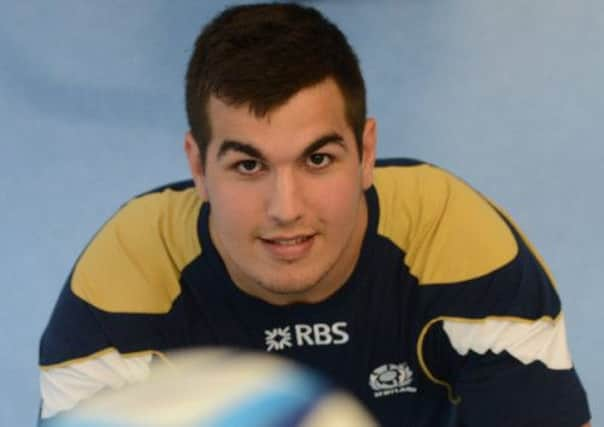Moving from No.8 to No.2 will be a test for McInally


After coming through all the age grade teams and building his professional career as a No.8, McInally will now enjoy a close up of the action from the very middle of the scrum by morphing into a hooker.
The idea was the brainchild of Scotland’s new director of rugby Scott Johnson, who has been in situ for a matter of months. But was the move lapped up by an eager and appreciative McInally or did Johnson’s suggestion come with menaces? Perhaps the poor player woke up with a horse’s head in his bed, or maybe in these straitened times, just a hamster’s. In other words, was he made an offer he could not refuse?
Advertisement
Hide AdAdvertisement
Hide AdIt’s worth asking the question because it is not obvious why McInally should move now, fully three years further down the line than Ross Ford was when he made the same switch.
At just 23, McInally is in the foothills of his professional career with his best years ahead of him.
Size seems to be the issue because, at least in comparison with his competition, McInally is not built for running through brick walls – although he is never less than competitive, even when Edinburgh are under the cosh. He is a warrior and, more importantly, an intelligent player who instinctively takes the right option at the right time, which is a priceless commodity to be peddling in a key decision-making position.
Every self-respecting scrum-half these days can do a turn at No.10 and Sean Lamont is more versatile than most, having filled every outside back jersey for Scotland.
But there is a long history of more radical positional changes. Alex Brewster won three caps on the flank from 1977-80 and another three at prop six years later after bulking himself up. Roland Reid’s switch from No.8 to wing was less successful and he returned to the back row, but not before winning two caps and scoring on his debut against Tonga.
The less said about Mauro Bergamasco’s disastrous switch from flanker to scrum-half for Italy at Twickenham the better, however.
South of the border, Andrew Sheridan was a Bristol lock before becoming a much-lauded England prop. Kris “the next Jonah Lomu” Chesney started on the wing before the Saracens and Toulon stalwart switched to the second row. Bath and England’s Matt Banahan made the reverse move having been recruited to the Rec as a lock from the London Irish academy – as you’d expect from someone who is 6ft 7in in his bare feet.
Closer to home Sean Lineen never did follow through on his threat to move Johnnie Beattie to the centre, a position the No.8 filled at school.
Advertisement
Hide AdAdvertisement
Hide AdFord made the move from back to front row after spending his youth as a flanker and England’s Tom Youngs went one better at the urging of the then Leicester coach Heyneke Meyer, switching from being a hard-running centre to being a hard-running hooker, but it’s worth noting that both he and Ford made the move relatively late in life and subsequently struggled with their lineout throwing. That’s before we even talk about the forgotten art of hooking.
There is an old army saying that suggests generals are always fighting the last war and that appears to be true of McInally’s move. We have been living in an era when front rows have muscled up remorselessly in a kind of scrummaging arms race.
In the past, Argentina were famous for effectively fielding three props in the front row for their Bajada scrummaging method which channelled much of the power through the hooker. Nowadays almost everyone does the same, but that may be changing.
The IRB’s new instructions, requiring scrum-halfs to feed the ball into the middle of the scrum, rather than the second row’s feet, should bring back the lost art of striking for the ball.
A friend of mine at college used to show off by hooking the ball with his head on the ground, as he was occasionally required to do in a match. The scrum won’t return to that situation but hookers are once again having to shake a leg at the ball while relying upon their props to hold up the world. It’s not always easy. Wallaby Steven Moore found it impossible to hook the ball during one scrum in last weekend’s Bledisloe Cup simply because he was under too much pressure from the All Blacks. It resulted in a turnover.
McInally may not be huge for a No.8 but he is pretty tall for a hooker and, in addition to the throwing and scrummaging aspect of his new life, he will likely be required to learn how to hook the ball which is a tall order for a man who may tower over his twin props.
He may think he has a better chance of an international career in the front row but even that isn’t obvious because McInally boasts the ability to play across the back-row and Scotland are not badly off for hookers. Ford enjoys top billing but he has competition from Edinburgh duo Alun Walker and Steve Lawrie, in addition to the Glasgow trio of Pat MacArthur, Kevin Bryce and Fraser Brown, any one of whom could put their hand up in time for the 2015 Rugby World Cup.
Even if the powers that be do consider Scotland to be desperately short on hookers there are at least two mobile, ball-handling, athletic props who could make the switch with relative ease – Alasdair Dickinson and Geoff Cross.
Advertisement
Hide AdAdvertisement
Hide AdIf anyone can pull off such a move, it could be McInally, who appears to have the right mix of skill and sheer bloody-mindedness. But he would surely have had enjoyed his rugby career more by staying in the middle of the back row.